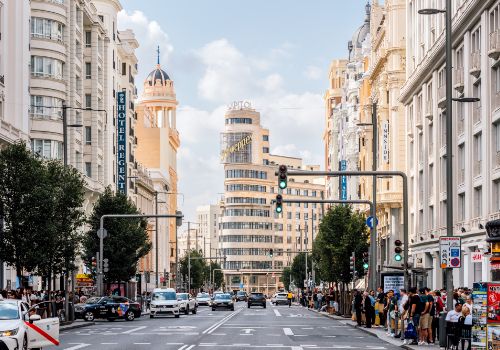Guerin® Blog
Driving Tips
Driving in Spain: Everything you need to know
Share
Planning a quick getaway to the neighbouring country? It’s always a good idea. But before you set off, it’s important to understand that there are a few key differences between driving in Spain and Portugal. Guerin breaks down everything you need to know before hitting the road.
Visiting Spain by car
With its diverse climate, Spain is an inviting destination all year round. Its beaches are perfect for a short summer break, while in winter the country also offers great conditions for skiing and snowboarding.
With so many options, it’s no wonder Spain is a top choice for many Portuguese travellers and for those who are visiting Portugal and decide to make the most of their trip by exploring the neighbouring country.
In both cases, the car is often the preferred mean of transport, thanks to the proximity between the two countries.
A guide to driving in Spain
Driving rules in Spain are broadly similar to those across the European Union, so Portuguese drivers shouldn’t face too many challenges. That said, there are a few differences worth noting.


Drink-Driving Limits
There’s a slight difference in the maximum blood alcohol limit for professional drivers and new drivers (those who’ve held a licence for under 2 years). In Portugal, the limit is 0.2 g/l, while in Spain it’s 0.3 g/l. For all other drivers, the limit is the same: 0.5 g/l.
Speed Limits
Generally, speed limits on motorways and main roads are the same: 120 km/h on motorways and 90 km/h on national roads. However, in urban areas, the maximum speed is often lower – in some zones, it’s just 30 km/h, compared to 50 km/h in Portugal. Always pay close attention to road signs when driving in Spain.
Mandatory Equipment
If you're just passing through, you only need to carry one warning triangle. However, if you ever become a Spanish resident, you’ll be required to carry two. Both must be used if your car breaks down on the road.
You must also have a spare tyre in good condition and the necessary tools to change it – unless your vehicle comes equipped from the factory with a tyre repair kit instead.
Foreign drivers are only required to wear a reflective vest if they have to walk along a road or motorway. That said, we recommend wearing it for your own safety so you’re clearly visible to other drivers.
Lights
Motorcyclists must keep their lights on at all times – day and night. For all other vehicles, lights are only mandatory in low visibility conditions, just like in Portugal.
Travelling with Children
If you’re travelling with family, note that children under 12 years old and shorter than 1.35 m must use a child seat suitable for their size and weight. If they’re over 1.35 m but still under 12, they can use a seatbelt without the child’s seat.
Parking
As in bigger Portuguese cities like Lisbon or Porto, parking in the biggest Spanish cities often comes with time restrictions. In many urban areas, you’ll find different parking zones:
Blue zones: Paid parking for a limited time.
Green zones: Generally, reserved for residents, with unlimited or restricted hours depending on local rules.
Tolls
Most roads in Spain’s national network are toll-free, including expressways. However, some motorways do require toll payments, particularly those around major cities – where peak-hour charges may apply.
Paying Fines
If you're a foreigner and not a resident, Spanish traffic police are authorised to request payment of fines on the spot. Fines can be appealed within 15 calendar days. A 50% discount is usually available if you pay immediately or within 20 days of receiving the notice.
Enjoy your holiday in Spain
Now that you know the key rules for driving in Spain, there’s no excuse. Follow the regulations, watch out for signs, and avoid unnecessary fines. Before you hit the road, don’t forget to add the optional Premium Road Assistance service, which offers support both in Portugal and abroad.
Share


